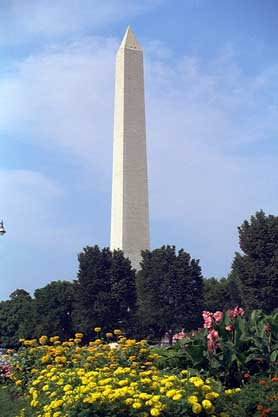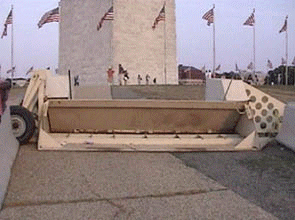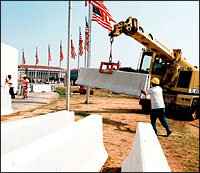 The visual environment of Washington, DC, is textured by the intricate patterns of aesthetics, memory, and politics. Increasingly, a lot of what we see around is menacing: there are more and more visual gestures of power, aggression, and fear, and less of the innocent flag waving that tourists come to see and we remember from childhood. Both to decode it all and make everything somewhat less frightening, I have found it useful to regard those gestures as purely artistic exercises. After all, even the most dangerous cur loses its bite when transformed from an actual dog to a symbol of a dog -- postmodernism as a form of self-defense. Thus, I try to pretend that one of the most disturbing sights of contemporary Washington is in fact an art installation.
The visual environment of Washington, DC, is textured by the intricate patterns of aesthetics, memory, and politics. Increasingly, a lot of what we see around is menacing: there are more and more visual gestures of power, aggression, and fear, and less of the innocent flag waving that tourists come to see and we remember from childhood. Both to decode it all and make everything somewhat less frightening, I have found it useful to regard those gestures as purely artistic exercises. After all, even the most dangerous cur loses its bite when transformed from an actual dog to a symbol of a dog -- postmodernism as a form of self-defense. Thus, I try to pretend that one of the most disturbing sights of contemporary Washington is in fact an art installation.
The art in question involves the Washington Monument and its end of the Mall, which includes the gentle hill upon which the Monument itself is perched, the Reflecting Pool, and the Lincoln Memorial. We all know the site. We have all been there, had our pictures taken, and even felt the desired patriotic response. It is one of the most sacred places in the shared landscape of the American imagination, something that any former graduate student in history would unhesitatingly label a "site of memory" par excellence. It hails grandeur of the spirit: the magnificence of Washington himself; the promise embodied by the young Republic that he launched and guided; Lincoln, his most worthy heir; having personified, defended, and advanced the best of that Republic's ideals; and the famous speech by Martin Luther King Jr., who took Lincoln at his word and made us all a better people. Standing at the height of the hill, at the base of the soaring marble obelisk, we feel ourselves to be at the summit and center of civilization. The power and the glory is ours.
 The contemporary "installation," however, is something radically different, and subversive. It consists of two elements: the chain of Jersey barriers strung defensively around the base of the Washington Monument and the construction site situated between the Monument and the Reflecting Pool that will one day become a World War Two memorial. As a single installation - let's call it Anxiety - it subtly and efficiently exposes our contemporary vulnerability, our uncertainty, and our burgeoning sense of doom and decline. Beginning with the Washington Monument, the ring of Jersey barriers deftly deflates the brash confidence of the obelisk. Where is the power and the glory when were are all paralyzed by nightmare visions of truck bombs?*
Where is our strength when we can muster no better response to that perceived threat than crude construction barriers?
The contemporary "installation," however, is something radically different, and subversive. It consists of two elements: the chain of Jersey barriers strung defensively around the base of the Washington Monument and the construction site situated between the Monument and the Reflecting Pool that will one day become a World War Two memorial. As a single installation - let's call it Anxiety - it subtly and efficiently exposes our contemporary vulnerability, our uncertainty, and our burgeoning sense of doom and decline. Beginning with the Washington Monument, the ring of Jersey barriers deftly deflates the brash confidence of the obelisk. Where is the power and the glory when were are all paralyzed by nightmare visions of truck bombs?*
Where is our strength when we can muster no better response to that perceived threat than crude construction barriers?
 The choice of materials is itself ingenious. Their drab, weathered look mocks the bright garland of American flags that form an inner ring around the Monument. In contrast to the masterfully-hewn pure white marble of the obelisk, moreover, the barriers are cheap, impermanent, and mass produced. The very name, which I assume refers to New Jersey rather than the breed of cattle or the British territory, underlines their ordinariness. The barriers in particular evoke images of the New Jersey Turnpike and that dreary corridor between Trenton and New York City that most East Coasters have traversed more times than they can remember. Traffic, construction, frustrated movement, the profane and the quotidian: these are direct opposites of the ideas and values normally evoked by the Monument.
The choice of materials is itself ingenious. Their drab, weathered look mocks the bright garland of American flags that form an inner ring around the Monument. In contrast to the masterfully-hewn pure white marble of the obelisk, moreover, the barriers are cheap, impermanent, and mass produced. The very name, which I assume refers to New Jersey rather than the breed of cattle or the British territory, underlines their ordinariness. The barriers in particular evoke images of the New Jersey Turnpike and that dreary corridor between Trenton and New York City that most East Coasters have traversed more times than they can remember. Traffic, construction, frustrated movement, the profane and the quotidian: these are direct opposites of the ideas and values normally evoked by the Monument.
* In an ironic twist, the Jersey barriers were placed around the Monument in 1998, due to fears of a truck-bomb attack in reprisal for American bombings in Sudan and Afghanistan. Bombings against whom? A little-known group called Al Qaeda.
Washington Post Story



film politics music jay's head poetry art josh ring fysche saddies about archive